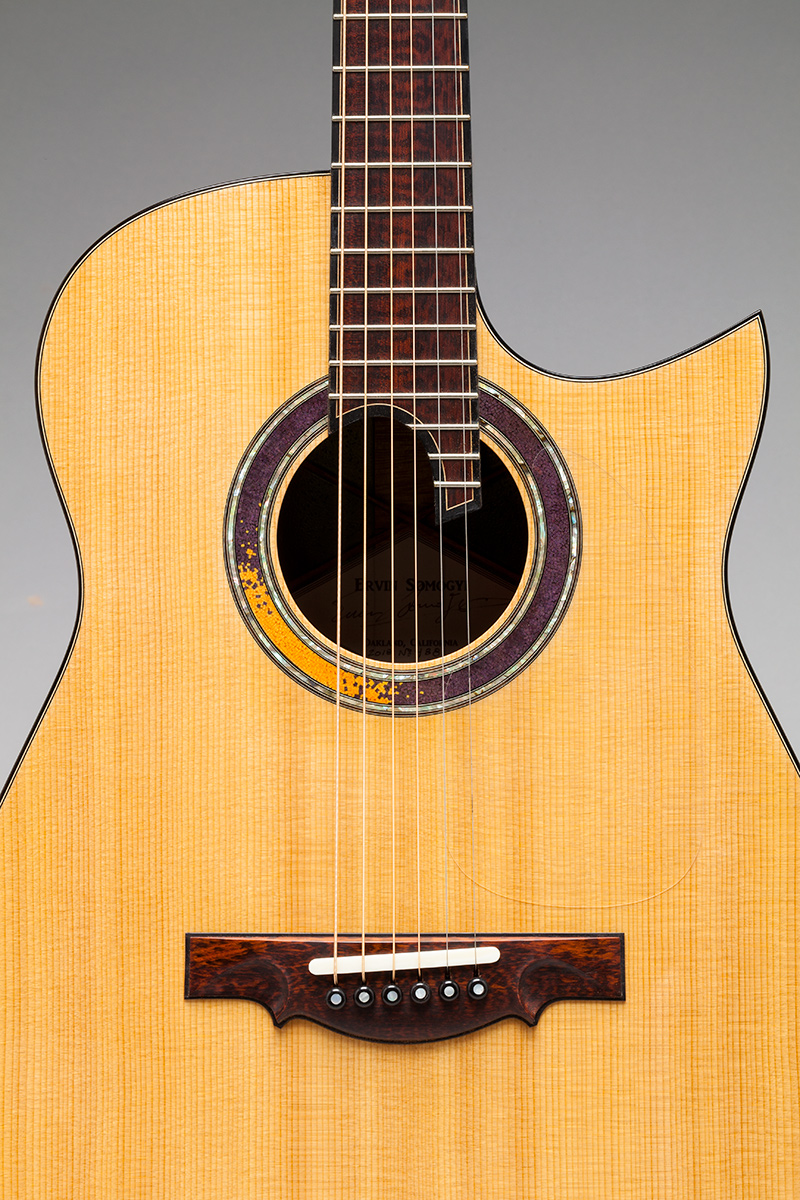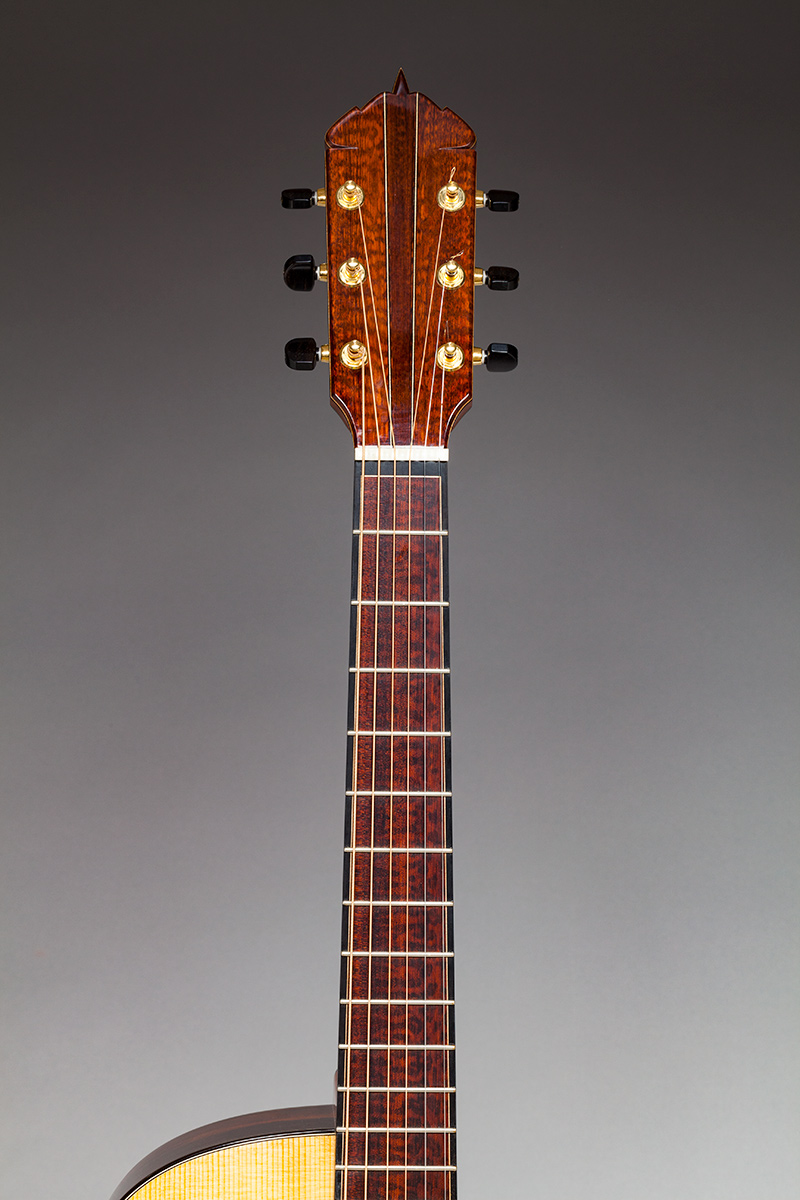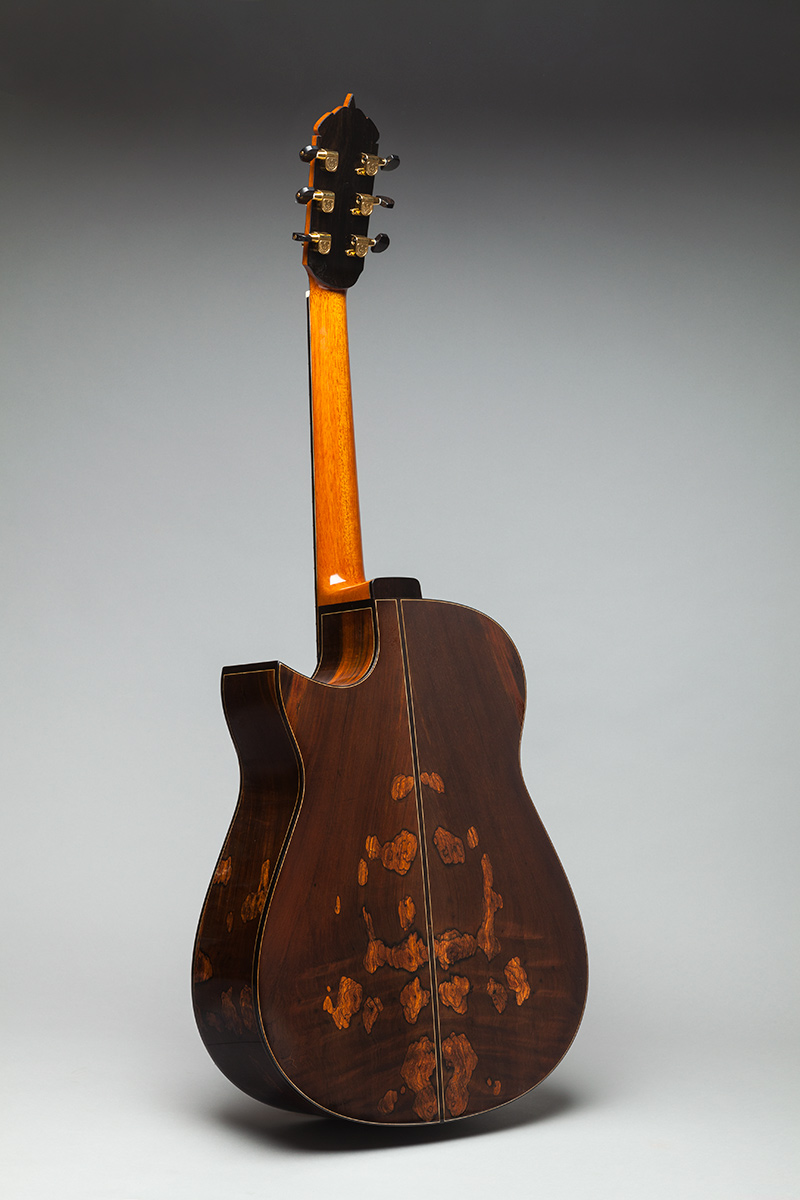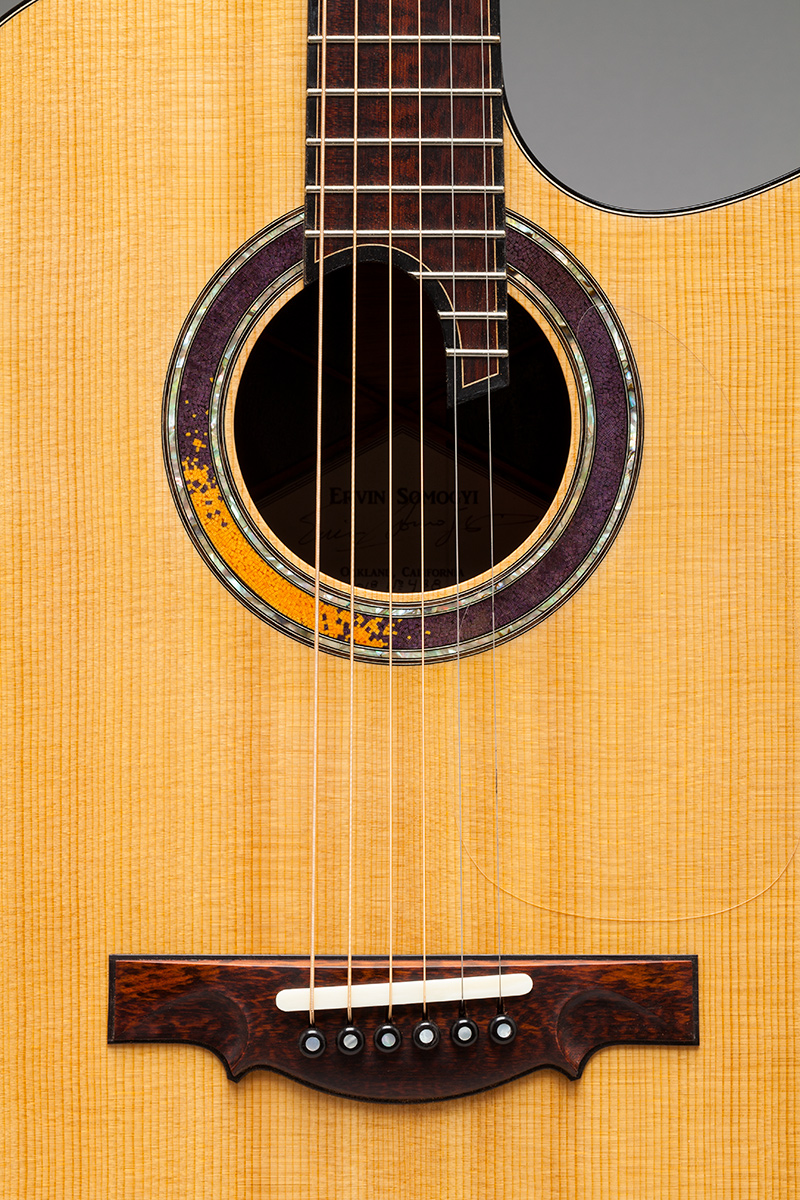- Guitar #488 is newly completed. It’s labeled 2019 but actually got done in 2020 because other projects in the shop needed to be completed first.
- This guitar is a Modified-Dreadnought cutaway guitar with Sitka spruce face and spalted Brazilian rosewood back and sides (see note #1 further below).
- This guitar has a snakewood fretboard with ebony binding (see note #2, further below), and matching snakewood bridge, and matching snakewood peghead veneer. Snakewood is called that because its figuring is reminiscent of the scales on a snake’s body (see note #3, further below).
- This is a 12-fret guitar, with a fretboard extension over the soundhole that provides the player with the normal number of frets (see note #4, further below).
- This guitar is French polished (see note #5, further below).
- The tuners are Gold Schallers with ebony buttons.
- The cutaway on this guitar offers three frets’ complete clearance for the left hand, and the better part of a fourth fret’s worth. Many cutaways only offer two or three frets’ clearance.
- The nut and saddle are of bone; the saddle is fully compensated for proper intonations.
- There is a clear plastic pickguard. It is the only plastic on the guitar; everything else is solid wood.
- It has a wood-mosaic “sunset” rosette, with abalone shell bordering (see note #6, further below).
- This guitar is, as are all my instruments, personally voiced by me. If you like its sound, it’s my faultf you don’t like this guitar’s sound, it’s my fault. But I think it has a fabulous voice (see note #7, further below).
- Personally speaking, I think this is one of the most beautiful guitars I’ve made.
PRICE: $42,000
NOTE #1: “Spalt” refers to partial decomposition of a wood; it results in spotting or streaking in the wood itself; this effect is caused, slowly and over time, by destructive microbial action. If one allows the bacteria to act for too long then the wood is rendered unsuitable for use; but the figuring that can occur before the wood is too damaged can be spectacular.
Wood loggers can intentionally produce spalted maples that are astonishingly beautiful. The technique for doing this involves keeping a pile of stickered planks of wood moist, warm, and under a tarp, after a specific bacterium/spore has been injected into it. One then waits for a few weeks, checking the progress of the decomposition/rot every week or so, and when the desired level of figuring and streaking has been achieved one removes the tarp from the stack and allows the wood to dry out.
Tropical hardwoods are not treated like this for several reasons; the main one is that there aren’t enough of these woods to set aside to subject to such treatment. Accordingly, the few samples that are occasionally available will have been gotten from trees that fell over a long time ago, sat in water, and started to rot away. Also, dealers in tropical lumbers do not like such wood; they throw it away. Thus the supply of this wood is even more limited. However, spalt can add a level of visual splendor to any wood regardless of whether it is “created under laboratory conditions” or occurs naturally.
NOTE #2: I discovered a long time ago that a fingerboard with a border (its binding) around it looks more elegant than one without, and on which the fret slots are visible on either side of the fingerboard. Most commercially made guitars have plastic fretboard binding on either side of the fretboard only; mine have wood binding on all four sides – with mitering on all four corners. And in echo of the look of the guitar’s binding and purfling, these bound fingerboards contain a contrasting “pin stripe” of purfling as well.
NOTE #3: Snakewood is a relatively scarce and expensive wood that is beautiful, but problematic to work. It cracks very easily, so that any board or chunk or plank of it will contain a lot of waste because of those cracks. It is also hard to work because it is brittle: it splinters and chips if one is not careful. And finally, it comes from small trees; it is almost impossible to find pieces large enough (and problem-free enough) to make furniture – and let alone two-piece guitar backs and sides – out of.
NOTE #4: The 12-fret configuration places the bridge in a different position on the face than the 14-fret design does (this is instantly recognizable by the fact that the standard 14-fret neck places the bridge so that it is closer to the soundhole than to the bottom of the guitar; the 12-fret design places the bridge in the middle right between the soundhole and the bottom of the guitar).
Visuals aside, the significance of the altered bridge position is that the sound of the instrument is changed. As a rule, a 12-fret guitar sounds warmer and sweeter than a 14-fret one does. The 14-fret design places the bridge at the location from where the strings’ vibrational energies are most likely to produce the loudest and most present sound. The 12-fret model might be described as not so much a concert/performance instrument as one that will be unbeatable when played in a smaller, more intimate setting in which there are fewer listeners.
NOTE #5: French polish is the hand-application of a shellac finish that is at the end rubbed out to a high gloss. It was the traditional and best finish for wood in the days before lacquers, urethanes, catalyzed and ultraviolet-cure finishes, etc., arrived on the scene. French polish has several advantages, and perhaps a few disadvantages. One advantage is that it is very thin compared with any of the other finishes that are used these days; this allows the guitar’s main diaphragms (the top and the back) maximum freedom of vibratory movement; this results in a louder and more present sound.
It is a non-toxic finish, as its solvent is alcohol. One can dissolve the shellac flakes in either ethanol or methanol; the principal difference is that one can drink ethanol, but not methanol; the latter is poisonous. [NOTE: Methanol itself was created during Prohibition . . . that period of time in the 1920s when Americans decided that alcohol was a tool of the Devil and needed to be abolished. Accordingly, petrochemical impurities and additives were mixed in with ethanol so as to render it poisonous for humans to drink. As we all know, Prohibition eventually went away; methanol did not. The reason that we still have methanol is that the liquor industry doesn’t want its customers getting their booze from the local hardware store.]
The thickness of a properly applied French polish is anywhere between the thickness of a soap bubble (.001) and the thickness of a sheet of typing paper (.004”). Lacquers are often on the order of .008” to .012” thick, and lacquer is a denser substance than shellac is.
One can sometimes see cracks in the finishes of older lacquer-coated guitars. This is called “crazing”, and it happens because the lacquer is thick and hard enough to crack over time. French polish is not subject to crazing. The crazing is not a problem, really; the heaviness of the lacquer is, though — as far as guitar sound is concerned. Because of its relative heaviness, a lacquer finish will damp the sound of a guitar much more so than a French polish ever could.
One disadvantage of French polish is that, because it is so thin, it does not protect a guitar against scratches and wear as does a lacquer finish. French polish is so thin that it offers minimal protection. However, the principal function of any finish — besides enhancing the woods that it covers — is to protect wood against changes in the weather. Wood is hygroscopic; that is, it swells and shrinks depending on how much moisture is in the air. That movement can promote cracking and checking in woods. Therefore, I tell my customers that the function of a French polish is to (1) allow the instrument its full and present voice, and to protect its woods from the weather . . . but not the player. I expect people who own my guitars to take reasonably good care of them.
Nonetheless, in case of damage, French polish is easy to touch up by anyone who knows how to work with it. And speaking of knowing how to work with it, mastery of French polishing is a genuine skill; it takes less skill to apply lacquer onto a wooden surface with a spray gun. Along with that, the urethane, polyurethane, and ultraviolet-cure finishes are not easy to repair in case of damage. The entire finish has to be removed, and a new one reapplied.
There is one other thing: lacquers and the synthetics are high-gloss finishes. They are so brightly reflective . . . even “plasticky” . . . that they typically get in the way of one’s appreciating the woods themselves; the reflectivity gets in the way. Take a look at your own lacquered guitar and you’ll see what I mean. A French polish is shiny but not so glossy that it gets in the way of appreciating the colors and visual depth of the woods; these look more beautiful, and have more depth, even indoors where there is artificial lighting.
NOTE #6: The rosette is the traditional decorative inlay around the soundhole. It has nothing to do with anything outside of enhancing the look of the instrument. Factories install the easiest and most trouble-free rosettes that they can; frequently these are two or three concentric circles made of either plastic or wood. Luthiers frequently go to all kinds of trouble to make rosettes that are distinctive and unique. These too are usually circular and they feature wood mosaic designs that are repeated all around the soundhole. Such rosettes typically contain between 3,000 and 4,000 little pieces of wood.
The rosette on this guitar is a wood mosaic one with abalone shell bordering, but it is different in that it’s not the same look all around. I call this my “sunset” rosette, because the colors are crepuscular. I like that word; it refers to the twilight-like quality of light becoming darkness, or darkness becoming light. It reminds me that part of a sunset or a sunrise when you can only just see things as it gets darker, or just begin to see things as the sky begins to lighten. I think it looks beautiful.
NOTE #7: I find the process of the voicing of a soundbox to be fascinating. I specialize in this work, and am considered to be an authority on it. Each guitar is a bit different and there’s always something new to learn . . . depending on the size of guitar, the species of wood being worked, the specific bracing layout in question, the temperature and humidity in the room in which the work is being done, the qualities of tone that my customer/client has voiced a preference for, and even the size of the soundhole/soundport.
“Voicing work” is that series of procedures that focus on shaping the vibrating plates and their components (the braces) to the specific thicknesses, stiffnesses, profiles, tapers, etc., that will allow the instrument to have its fullest and sweetest voice. It’s a bit like surgery combined with engineering: one needs (1) to have an idea of just where to cut, shave, taper, sand, and shape the wood, and (2) exactly how much of it to do, and (3) what it does – that is, to know what kinds of manipulations of relatively small amounts of wood will shift the sound of the instrument in this or that direction — and (4) to have a sense of having gone not far enough or having gone too far.
It’s an essential skills-set that takes time to learn and master, but it is one that is not taught in any of the schools nor mentioned in any of the many how-to books that are in print . . . with one exception. As far as I know I’m the only luthier who had described these procedures in written form; they are the subject matter of chapters 18 and 19 of my book The Responsive Guitar. This is not necessarily because I’m smarter than other luthiers; rather, it is (1) because I’m a better writer than a lot of them are and, more importantly, (2) it is a procedure that is so hands-and-ears-on, and so full of subtlety, that it’s difficult to describe with mere words. The woods have to feel and sound right.
Voicing work is necessarily part of structural work. One of the most important adages in Spanish guitar making is to make the guitar so that it is “on the cusp of disaster”. That means that it is NO STRONGER than it needs to be to hold together under string tension and the rigors of being played; and it is NO WEAKER than that either, because to make it so will ensure eventual failure (breakage or collapse). One can understand that a soundbox that is built to that balance point will be able to vibrate and resonate as fully as possible . . . because it is not being held back by superfluous mass or stiffness . . . and that it is simultaneously strong enough to hold together. It’s a tricky balance point to achieve.
The pacing of Voicing work is rather slow. I remove small amounts of wood from here and there, and listen to the change in tap tone that that removal produces. I use the sounds of various types of tap tones as an indicator of how track how close to “right” the soundbox is at. This work takes me a full day, and often two days, to do properly. I not only listen to the progression of the guitar top’s tap tones, but I periodically press on the wood gently with my thumb; I can sense the top getting looser and more yielding as I remove wood. It’s a little bit like doing C.P.R., where the subject’s rib cage sinks in as one applies rhythmic pressure — except that in this case the pressure is not great. My guess is that if you try this with whatever guitar or guitars you now own the top(s) will not move easily under your hand’s push. That’s how other guitars are built.
I once showed one of my clients my procedure for Voicing, on the guitar I was making for him; he had been persistent in asking me to do this and I finally agreed — on the condition that he not photograph nor ever describe the procedures to anyone else. Afterwards, he said it was like watching his favorite color of paint dry. But from my point of view this is always a meditative process in which I “converse” with the soundbox; and I cannot do this if I’m thinking of anything else. No one can; one has to be relaxed and focused on the task.
On the whole, I must be doing something right. My guitars do have the reputation of sounding good.
MANDATORY SURGEON GENERAL’S WARNING: The sound of Somogyi’s guitars has been found to be so intoxicating that you are seriously warned to not play any of them while driving or operating heavy machinery.







